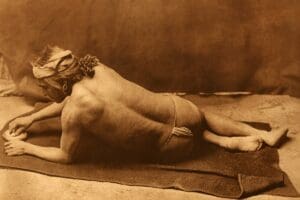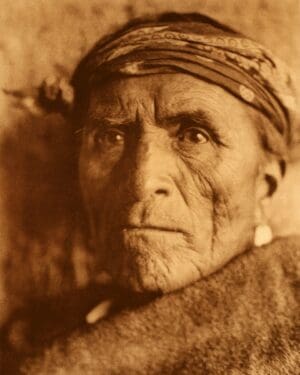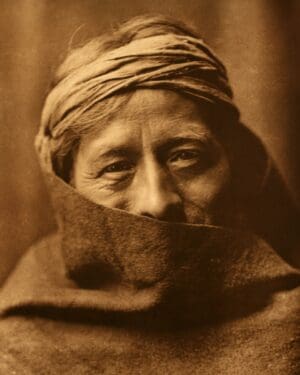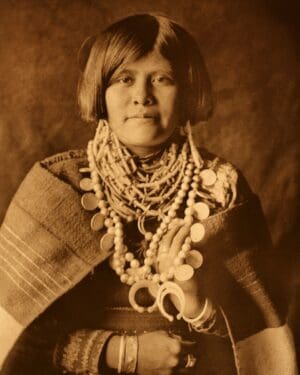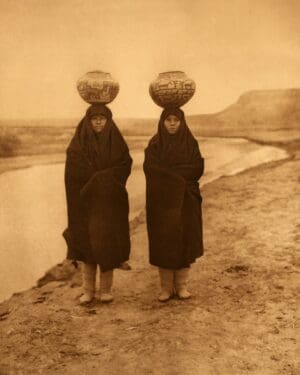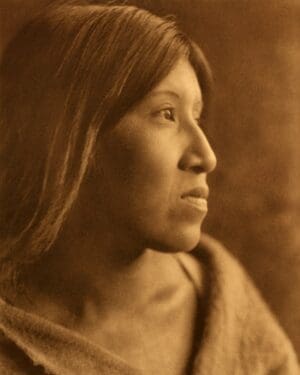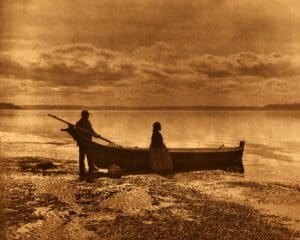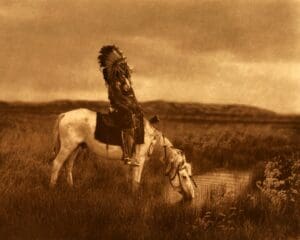Zuni Native Americans
Zuni Indian Photos by Edward S. Curtis
Tribal Summary
Dress
Zuni men wore loin-cloths, fringed white cotton sashes, deerskin moccasins with rawhide soles, and short leggings. In warm weather the other parts of the body were ordinarily exposed, but they had short trousers of fabric or skin, and robes of cotton or skin, some of the latter being painted. Buffalo-skins were obtained from the Rio Grande pueblos. Both sexes had woven footless stockings, which, made of wool, are still seen. Sandals were made of yucca. The modern ordinary dress of a Zuni man consists of white cotton trousers, a loose-hanging cotton shirt, a loin-cloth, and moccasins. Men part the hair from ear to ear, cut it square in front, and double up the back portion and tie it with a piece of yarn or a woolen band. Headbands are commonly worn. The dance-costume is the usual Pueblo one – embroidered kilt, white fringed sash, moccasins colored blue-green and with a heel strip ornamented with porcupine-quill work, skunk-fur anklets, a fox-skin pendent behind, silver wrist-guard, turtle-shell rattle at the knee, gourd rattle in the hand, and numerous ornaments and painted figures. Masks are often worn.
Zuni women wore, and still wear over cotton undergarments, the usual Pueblo dress fastened over the right shoulder, passing under the left, and leaving arms and lower legs bare. Ordinarily they had no moccasins, and the lower legs were protected from cold by footless stockings. For ceremonial use they have white cotton robes draped over the primitive dress, and white moccasins with voluminous uppers wrapped around the leg. The front hair is cut square across at the level of the eyes and the ears.
Dwelling
Houses are built of fragments of stone set sometimes without binding material and without breaking joints. The walls are plastered on both sides with clay and whitened on the inside with gypsum wash. The flat, slightly sloping roof of brush and earth is supported by heavy pine beams stripped of their bark but not dressed. The quarters of a family are an apartment in a terraced structure containing hundreds of rooms. Houses on the ground level were formerly entered through the roof by means of ladders. The upper levels are still reached either by ladders or by stone stairs ascending from one roof to another. Doors of an upper story open directly upon the roof of the chamber below, and the roofs are regarded as public thoroughfares. The fireplace is set usually in a corner of the room, and a clay-covered hood of sticks deflects smoke upward through an external chimney consisting of a stack of bottomless pots. Prior to 1880 Zuni had here and there six stories. In recent years the maximum height was four tiers, and in 1919 the fourth story, a single apartment, was demolished. Numerous separate outlying houses have been built, and adobe bricks are more and more being used instead of stone.
Food
Primitive Zuni had the cultivated plants common to all the Pueblos – corn of many hues, beans, and squashes. Corn is ground on metates, three in a set, and is prepared in a very large number of ways, the most unusual of which produces the colored, paper-thin bread called hewe. Pinons, acorns, roots, pot-herbs, cactus fruit, and yucca seedpods were among the important wild products. Rabbits and hares, before the introduction of sheep, were most important, not only for their flesh but for the soft fur, which, cut into long snips, was converted into warm blankets with yucca-cord warp. Antelope, deer, elk, and mountain sheep were hunted less frequently. The Zuni were remote from the buffalo range, but the skins of these animals reached them through the channels of trade.
Showing 1–9 of 12 results
-
Sale!
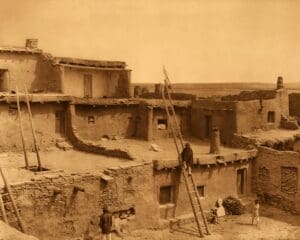
Corner of Zuni
$18.95 – $120.95 -
Sale!

Grinding medicine – Zuni
$30.95 – $173.95 -
Sale!

Inscription rock
$18.95 – $120.95 -
Sale!

Load of fuel – Zuni
$18.95 – $120.95 -
Sale!

Lutakawi, Zuni Governor
$18.95 – $120.95 -
Sale!

Terraced houses of Zuni
$18.95 – $120.95 -
Sale!

Waihusiwa, a Zuni kyaqimassi
$18.95 – $120.95 -
Sale!

Zuni girl
$18.95 – $120.95 -
Sale!

Zuni girls at the river
$18.95 – $120.95

